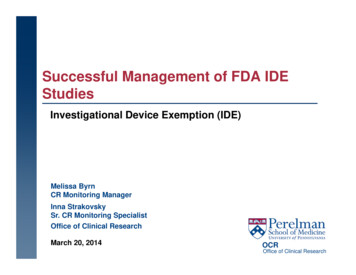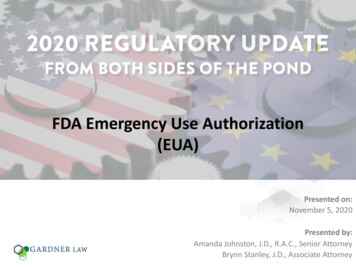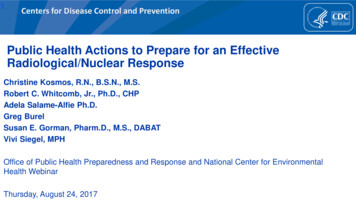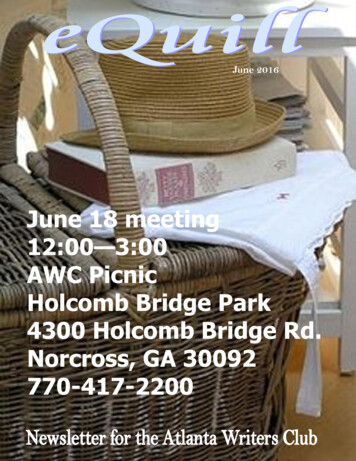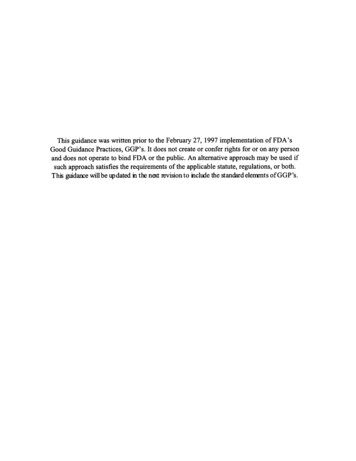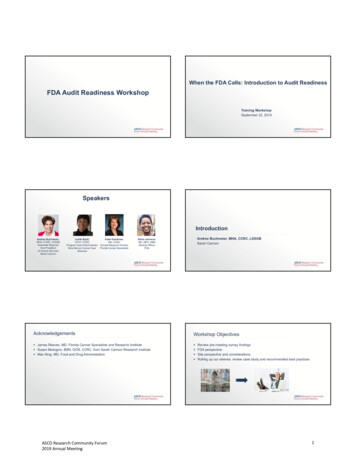
Transcription
When the FDA Calls: Introduction to Audit ReadinessFDA Audit Readiness WorkshopTraining WorkshopSeptember 22, 2019SpeakersIntroductionAndrea Buchmeier,MHA, CCRC, LSSGBAssociate RegionalVice Presidentof Cancer ServicesSarah CannonKatie Goodman,Leslie Byatt,RN, CCRCCPhT, CCRCProgram Grant Administrator Clinical Research DirectorFlorida Cancer SpecialistsNew Mexico Cancer CareAlliancesAndrea Buchmeier, MHA, CCRC, LSSGBSarah CannonAisha Johnson,MD, MPH, MBAMedical OfficerFDAAcknowledgementsWorkshop Objectives James Reeves, MD, Florida Cancer Specialists and Research Institute Susan Modugno, BSN, OCN, CCRC, from Sarah Cannon Research Institute Max Ning, MD, Food and Drug Administration ASCO Research Community Forum2019 Annual MeetingReview pre-meeting survey findingsFDA perspectiveSite perspective and considerationsRolling up our sleeves: review case study and recommended best practices1
Workshop ToolkitDisclaimer Objective: The workshop and toolkit were developed from personal experiences with FDA auditreadiness. Provide tools and resources to assist oncology researchprograms with ensuring FDA audit readiness Content covered: The views expressed in this presentation are those of the speaker and notthe institution to which they are affiliated Triggers of an audit Questions to ask FDA Pre-audit, during-audit, exit interview, and post-auditconsiderations The tips, guidance on best practices, and resources, are provided as examples onlyfor consideration. Features:The presenters and ASCO make no warranties, expressed or implied, as to resultsobtained by individuals using the information and is not responsible for any actiontaken in reliance on the information contained herein. Checklists, templates and forms Helpful references Toolkit next steps Share your resources to contribute to the toolkit! Revisions and make public – posted online (RCF website),feature in webinarDisclaimerFDA Perspective on Clinical Investigator InspectionsThe Views expressed in this presentation are those of the speaker and not necessarilythose of the Food and Drug AdministrationAisha Johnson, MD, MPH, MBAFood and Drug AdministrationCenter for Drug Evaluation and ResearchOffice of ComplianceOffice of Scientific InvestigationsDivision of Clinical Compliance EvaluationGood Clinical Practice Assessment Branch10Outline Introduction to Clinical InspectionsPDFUA/BsUFA Inspections ProcessInspections MetricsConsequences of NoncomplianceInspection MetricsClinical Site Inspection Preparation,QWURGXFWLRQ WR &OLQLFDO ,QVSHFWLRQV 11ASCO Research Community Forum2019 Annual Meeting122
Regulation of Clinical InvestigationsGeneral Responsibilities of Investigators (§312.60)An investigator is responsible for ensuring that an investigation isconducted according to the signed investigator statement, theinvestigational plan, and applicable regulations; for protecting therights, safety, and welfare of subjects under the investigator'scare; and for the control of drugs under investigation. Aninvestigator shall, in accordance with the provisions of part 50 ofthis chapter, obtain the informed consent of each human subjectto whom the drug is administered, except as provided in §§50.23or 50.24 of this chapter. Additional specific responsibilities ofclinical investigators are set forth in this part and in parts 50 and56 of this chapter. Federal Food, Drug, and Cosmetic Act (FD&C Act): 1938 (amended 1962)– Section 505(i) provides FDA the statutory authority for oversight of clinical investigationsto establish the safety and effectiveness of new drugs Code of Federal Regulations (CFR) 21 Subpart D, Part 54, Part 56– Delineates the responsibilities of Sponsors and Investigators in conduct of clinicalinvestigations– Financial disclosure, IRB Guidances– Non-binding advisory for Sponsors and Investigators to comply with the regulations13General Responsibilities of Investigators14Goal of Bioresearch Monitoring of Clinical Trials§ 312.60 - General responsibilities of investigators§ 312.61 - Control of the investigational drug§ 312.62 - Investigator recordkeeping and record retention§ 312.64 - Investigator reports§ 312.66 - Assurance of IRB review§ 312.68 - Inspection of investigator's records and reports§ 312.69 - Handling of controlled substances§ 312.70 - Disqualification of a clinical investigator To protect the rights, safety, and welfare of subjectsinvolved in FDA-regulated clinical trials; To verify the accuracy and reliability of clinical trial datasubmitted to FDA in support of research or marketingapplications; To assess compliance with FDA's regulations governingthe conduct of clinical trials.1516Types of InspectionsGood Clinical Practice (GCP)An international ethical and scientific quality standardfor the design, conduct, performance, monitoring,auditing, recording, analyses, and reporting of clinicaltrials that provides assurance that the data andreported results are credible and accurate and rights,integrity, and confidentiality of trial subjects areprotected. PDUFA/BsUFA-related inspections: New drugapplications For-cause inspections: GCP complaints Surveillance inspections: Compliance enforcementInternational Conference on Harmonization (for Registration of Pharmaceuticals for Human Use)ICH E6 (R2) 1.24; 201817ASCO Research Community Forum2019 Annual Meeting183
Outline of Process forPDUFA/BsUFA-Related InspectionsOffice of NewDrugsRecommendation onreliability of data3'8 ) %V8 ) ,QVSHFWLRQV 3URFHVVInspections RequestedInspection Report Reviewed,Final RegulatoryClassification Assigned(OSI)Sites Selected forInspection(OND, OSI)InspectionsAssigned to andConducted by FieldInspectors(ORA)19Site Selection Criteria20Clinical Inspections Activities Importance of the study Relevance to labeling Outliers (Number of Subjects/ ProtocolViolations/ Deaths/ SAEs) Statistical Impact of Data Findings of Previous Inspection(s) Domestic versus international Concern for Scientific Misconduct Specific Study Factors (variable) Compare data submitted to the Agency with source data(e.g., electronic/paper clinical records) Identify any instances where the data may not be identical Determine whether data was obtained according to theprotocol Determine if the rights, welfare and safety of subjectsinvolved were protected Ensure the conduct of clinical trials is in compliance withFDA's regulations2221Documents Field Inspectors Have at InspectionKey Inspection Focused Areas Study protocol(s) and amendment(s) Comparison of line listings with source documents and verification ofreported data and quality Review of enrollment process and signed consent from(s) Review of IRB oversights Review of monitoring activities Review of reporting to sponsor Review of compliance with applicable regulations (e.g., financialdisclosure and updates as indicated) Investigator’s brochure Sample consent form(s) Annotated case report for Data line listings for each study patient enrolled at the site Manual(s) related to key study conduct (e.g., submission of scansand/or tumor tissue) if applicable Others (e.g., Adjudication Committee Charters)23ASCO Research Community Forum2019 Annual Meeting244
Close Out MeetingFDA Form 483 Issued at the conclusion of an inspection when an investigator(s)has observed any conditions that in their judgment are objectionable(may constitute violations of the Food Drug and Cosmetic (FD&C)Act and related Acts) Discussed with clinical investigator Clear, specific and significant Investigators are encouraged to respond to the FDA Form 483 inwriting with their corrective action plan and then implement thatcorrective action plan expeditiously Discuss major inspectional findings Issue FDA Form 483 (if appropriate) Provide Post-inspectional Instruction2526GCP Compliance ClassificationAfter the InspectionNo Action Indicated (NAI)– correspondence acknowledges investigator’s/sponsor’s basic compliancewith pertinent regulationsFDA considers all information to determine what further action, if any,is appropriate Establishment Inspection Report All evidence or documentation collected on site Clinical investigator’s response to FDA Form 483Voluntary Action Indicated (VAI)– correspondence will identify the issues &, when needed, state that FDAexpects prompt, voluntary corrective & preventive action (CAPA) by theinvestigator/sponsorOfficial Action Indicated (OAI)– correspondence will request to submit a detailed corrective & preventiveaction plan (CAPA). Disqualification proceedings may proceed if theinvestigator does not respond appropriately2728Potential Penalties of Noncompliance Warning Letters Disqualifications, restrictions, or debarmentso Available to the publico Related to repeated and deliberate failure to comply withregulations Criminal prosecutions&RQVHTXHQFHV RI 1 RQFRP SODLQFH29ASCO Research Community Forum2019 Annual Meeting305
Warning LettersDisqualifications, Restrictions Notifies a responsible individual or firm that the Agency considers one or moreproducts, practices, processes, or other activities to be in violation of the FederalFood, Drug, and Cosmetic Act (the Act), its implementing regulations and otherfederal statutes Issued for violations of regulatory significance, i.e., those that may actually lead toan enforcement action if the documented violations are not promptly andadequately corrected One of Agency's principal means of achieving prompt, voluntary compliance Informal AdvisoryProhibition against conducting any clinical investigation that supports anapplication for a research or marketing permit for products regulated by FDAClinical investigator has repeatedly or deliberately: failed to comply with applicable regulatory requirements submitted false information to the sponsor or, if applicable, to FDA, in anyrequired report31Debarment32Ideal Investigator Site at InspectionProhibition against a person or company from submitting or assisting in thesubmission of an application for a new drug Cooperation throughout inspection/data audit Documented training of CI and research staff for the study by sponsor and monitor(s)– Re: the protocol, CRF, treatment administration, IP accountability, adverse eventsreporting, concomitant medications, protocol deviations, monitoring visits Demonstrated Investigator’s responsibilities and oversight of the conduct andknowledge of all critical aspects of the study, including delegation of responsibilities,study enrollment procedures, Records of protocol/amendments and IRB approvals before implementation in thestudy site Evidence of complying with the protocol, reporting events and protocol deviations tosponsor and, as necessary, to the IRB Applies to firms or individuals convicted of a felony under Federal law forconduct relating to development or approval of any drug product, orotherwise relating to any drug product under the Federal Food, Drug, andCosmetic Act Penalty set forth in a 1992 amendment to the Act Imposed on persons or companies that engage in criminal conduct withrespect to the development or approval of new drugs. As of April 2009, the FDA has debarred 73 persons FDA Debarment website33Ideal Investigator Site at Inspection (cont’d)34Summary Complete source documents and related case report forms fromscreening to each study visit, with no missing required records Maintained monitoring records and documentation of dataqueries and their resolution Complete records of investigational product accountability andhandling Complete information on Investigator’s and sub-investigators’credentials and financial disclosure Signatures for all required documentations and records Retention of records for appropriate length of time GCP in clinical investigations has specific requirements Clinical investigators are responsible for conduct of studies inaccordance with study protocols, compliance with applicableregulations, and protection of study patients. Inspection readiness results from investigators’ knowledge ofregulations and their real-time oversight of the conduct of studies,including adequate training and supervision of study staff Be proactive in prevention and correction of errors or deficienciesidentified35ASCO Research Community Forum2019 Annual Meeting366
Status of Inspections at OSI/CDEROverall inspections conducted in FY 2018 (including GLP, BE, and IRB inspections),QVSHFWLRQ 0 HWULFV For PDUFA/BsUFA related applications, 394 inspections conducted (as of 7/30/2018):86% for CIs3738Types of GCP InspectionsCDER FY 2015-2017, N 1767PDUFA/BsUFA Applications, FY 2018 Clinical Investigator 86% (343) Sponsor 10% (40) Contract Research Organization 4% (14)*Based on inspection assignment issued date – [FY2015-2017]39Frequency of Most Common GCP RelatedInspection Findings, CDER FY 2015-2017Frequency of Most Common GCP Related InspectionFindings, U.S.A vs. Non-U.S., CDER FY 2015-2017Based on Post‐Inspection Correspondence Issued (FY 2015‐17 ) for total of 1767 inspectionsBased on Post‐Inspection Correspondence Issued (FY 2015‐17 ) for total of 1767 inspectionsASCO Research Community Forum2019 Annual Meeting7
Useful LinksSpecial Thanks Dr. Max Ning, providing opportunity to speak to ASCO andcontribution of some slides Dr. Kassa Ayalew, GCPAB Branch chief, contribution ofslides, editing of presentation Clinical Investigator Responsibilities at CFR: https://www.ecfr.gov/cgi-bin/textidx?SID 85342f2ba76551ed53ba168bb4d10b8d&mc true&node sp21.5.312.d&rgn div6 Guidance on Investigator Responsibilities: https://www.fda.gov/media/77765/download Guidance on Financial Disclosure: https://www.fda.gov/media/85293/download Use of Electronic Records and Electronic Signatures in Clinical wnload FDA Good Clinical Practice Contacts: CDER-OSI-GCPReferrals@fda.hhs.gov4344FDA Clinical Investigator Inspections: Site PerspectiveAndrea Buchmeier, MHA, CCRC, LSSGBSarah CannonWhen the FDA Calls or Arrives UnannouncedAre you ready?What to ask? Which study is under review? What type of audit is it? What is the inspector’s name? When would they like to visit? What is anticipated length of inspection? Who will be coming with inspector? What records will they review? Notify all study staff Pull all ORIGINAL research records CRF And Source Documents; Including Signed Informed Consents Clinic Charts-certified copies or ensure access to EMR Regulatory Binder-IRB Approvals, Correspondence, Drug Shipping And ReturnInformation, Site Signature Log, Monitor Visit Log, 1572, CV’s, etc. May need: subject and staff schedules, telephone logs, subject sign-in sheets,temperature logs, calibration logs Review protocol Review CRF/source documents and informed consents for all subjects Review SAEsASCO Research Community Forum2019 Annual Meeting8
Are you ready? The InspectionReview regulatory binder - especially correspondenceOrganize documents if necessaryIdentify a conference room or private space for the InspectorAppoint a point person to make copies and escort the inspectorThe InspectionThe Interview Do’s and Don’ts Familiarize the Inspector with the surroundings; restroom,cafeteria Check in with the Inspector from time to time Make duplicate copies; one for Inspector, one for you Call your sponsor/institutional official at the end of eachinspection day or as agreed upon Meet with the Inspector at the end of each day Confirm the day and time for the next day’s visit Don’t be defensive Don’t get emotional Listen carefully and repeat the question or ask it to be repeated ifnecessary Answer completely, directly, and honestly Do not guess or make up the answer Do not provide your opinion, only the facts What Do You Think? What Is Your Best Guess? Do not volunteer more information than necessaryThe Interview Do’s and Don’tsThe Interview Do’s and Don’ts Never question the Inspector’s authority (remember, they have abadge!) Never argue or raise your voice Do not answer for someone else Do not agree or volunteer to change a policy without firstdiscussing with PI and/or Site Director ASCO Research Community Forum2019 Annual MeetingThere is no such thing as “off the record”It is OK to say “I do not know or I do not remember”Take notes of questions askedExpect what you say to be documented in a FDA field notebookLeave as soon as the interview is over9
Interview Questions for the PI How many studies have you been involved in?How many other studies were you involved in during this trial?How many active studiesWhat percentage of time did you devote to this project?How did the sponsor choose you?How were you trained on the protocol?Interview Questions for the PI Where was study drug stored?Who had access to the study drug?Did you see subjects at each visit?When did you review the source docs and CRFs?Who determined subject eligibility?Interview Questions for the PI How did the sponsor communicate your responsibilities?As PI, what are your responsibilities?How were sub-investigators and staff trained on protocol?How do you delegate responsibility?How did you recruit subjects?What did the consent process involve?Interview Questions for the PI How many subjects did you enroll?Who assessed AEs?Any SAEs?How often did the monitor visit?Did you meet with the monitor at every visit?Interview Questions for the PIInterview Questions for the Study Team Study specific questions and findings This will give you an opportunity to address issues andMAYBE keep them off the 483 Were you aware of . I found 3 missing consents, etc. ASCO Research Community Forum2019 Annual MeetingHow were you trained on this protocol?Was the PI available when needed?Who determined eligibility?Who assessed AEs?How did you recruit patients?How often did the sponsor monitor the study?Who had access to the study drug?10
CommunicationInspection Close-Out Keep the lines of communication open between the PI, thestudy staff, and the Sponsor/Institutional Official The PI, Sponsor and/or Institutional Official may request adaily update and should be available for a daily check in Always check in at the end of each inspection day Inspection ResultsInspection Close-Out The FDA Inspector will write and establishment inspectionreport (EIR) The EIR will be used by the FDA district office to classify thesite’s compliance and details the inspection, exit interview anditems listed on the form 483 A copy of the EIR will be sent to you after the inspection Schedule inspection post mortem Review what went well and opportunities for improvement Share learnings with everyoneTime to roll up our sleeves!Exit interview will go over findingsMany investigators receive a form 483This will go over in detail the results of the inspector’s findingsMake sure you understand what the 483 contains Listen, absorb, do not argue Send a copy of the 483 to your sponsor Response LetterCase StudyLeslie Byatt, CPhT, CCRC New Mexico Cancer Care AllianceKatie Goodman, RN Florida Cancer SpecialistsASCO Research Community Forum2019 Annual Meeting11
Answer: New Drug Applications/Routine InspectionA Phase 2 open label study for HER2 breast cancer hasbeen recruiting for over 2 years at 20 sites. Currently, 75% ofthe 100 expected patients have been enrolled.Great Outcomes Hospital has enrolled 15 patients. PI, DrHugh Raye has had very positive feedback from their patientsand have reported one SAE and no endpoint data. CrystalBall, CRC received a phone call from FDA Inspector Mr. DickTate, requesting a date and time for a two day Inspection. Routine selection based on a % of all clinical data submitted withNew Drug Application (NDA) OR Site with notably high or fast enrollment Site conducting multiple studies or large pivotal trials Site conducting study supporting a submission to FDA for NDA,marketing, license, etc.Before the FDA ArrivesA two-day FDA inspection has been scheduled at GreatOutcomes Hospital in five business days. This is thefirst time Dr. Hugh Raye and his team have been FDAinspected.Inspection Preparation Checklist Schedule pre-audit review meeting with internal team to discussstrategies Determine inspection accommodations Develop roles and responsibilities of staff during inspection Review study documentation and organize Prepare to welcome the inspector Sponsor/CRO communication planKnowing the Roles and Responsibilities of your Team ASCO Research Community Forum2019 Annual MeetingReview who is currently responsible for each step of the study processReview who was historically responsible (if applicable)Ensure staff understands on-going responsibilitiesEnsure pertinent staff are available12
Do You Have Everything? Study Summary ToolsAll required documents (organized, complete and current?)Review study team documentation (qualifications, training and delegations?)Review pertinent datesReview pertinent study team membersReview findings of recent monitors visitsList shortcomings for further discussion before the inspectionDuring the Inspection:When they arrive FDA investigator(s) should present credentials; if not, you mayask to view them FDA Form 482 – Notice of Inspection Entrance Interview with PI, Dr Hugh Raye and the study teamDuring the InspectionWhat to expect when inspected If requested, be prepared to give a guided tour of the facility Documents: Only give what is requested by the inspector Assign one staff member to manage all document requests. Thisincludes maintaining a record of all documents provided to the FDAinspector Designate plans for inspector communication PI communications plan, ensure frequent communication oninspection status Plan a daily update with your sponsor contactExit InterviewIt’s over what just happened? Ensure PI, Dr. Hugh Raye is available and invite other crucialdepartments as needed (i.e., Compliance, Leadership, etc.) FDA Inspector, Mr. Dick Tate will discuss oral “suggestions” or“discussion items.” If there are significant, serious findings, theFDA may issue a Form 483 Be sure to ask for clarification as needed Correct significant factual errors in discussion items during theexit conference since there is still the opportunity to keep themout of the Inspector’s report LISTEN AND LEARN!!The Form 483 lists observations made by the FDArepresentative(s) during the inspection.ASCO Research Community Forum2019 Annual MeetingIf the inspection does not yield any objectionable conditions orpractices, a 483 will not be issued.However, if the agency does issue one or more 483s at theconclusion of the inspection, it is always better to select “promiseto correct” rather than “under consideration” in response to each483 observation.13
It’s over what just happened?Warning letters are issued to manufacturers or other organizationsthat have violated some rule in a federally regulated activity, i.e.,violations of regulatory significance.Responding to the FDAA warning letter is one of the agency's primary means of achievingprompt voluntary compliance with the FD&C Act.DURING AN INSPECTION OF YOUR FIRM I OBSERVED:Response Cover LetterMs. X, District DirectorFood and Drug AdministrationDear Ms. X:I am writing in response to the 483 issued following the FDAinspection of our facility, Great Outcomes Hospital conducted by DickTate, Inspector, between 25 October 2018 and 5 November 2018. Mystaff and I carefully reviewed the inspector’s observations. In this letterwe have provided responses to each observation, includingclarification and further information on some of the observations. Irespectfully request that the information in the letter be taken intoconsideration in the agency’s review of the inspector’s observations.SITE RESPONSE TO OBSERVATION 1We understand the importance of SAE reporting and have reviewed each of theobservations and believe that the deficient SAE reporting was a result of clinicalstaff failing to alert the research staff of the SAE. As a result, we have reviewedwith our research coordinators, research staff, and all physicians that participate inour research program the importance of prompt reporting of any hospitalizations,serious adverse events, and deaths. We have reviewed this with our hospitalistsand mid-levels on the inpatient service as well.We are engaging with our education department to prepare an instructional slidedeck that must be completed to maintain research and hospital privileges.Additionally, we are modifying our electronic medical record to clearly indicatewhen a patient is enrolled on a clinical trial this EMR is viewed by any providersthat interact with the patient to ensure it is clear that additional reporting isrequired. Each of these actions will be completed by November 1, 2019. Lastly, wewill perform a process audit of our own SAE reporting processes in 6 months toensure this change has ensured ongoing compliance.ASCO Research Community Forum2019 Annual MeetingOBSERVATION 1Failure to report promptly to the IRB all unanticipatedproblems involving risk to human subjects or others21 CFR § 312.64(b)Specifically,Subject D01-002 was hospitalized with pneumonia on07/05/2016 and was never reported as an SAE.Subject D01-007 was hospitalized with myocardial infarction on08/10/16 as documented on 08/16/16 and not reported until08/21/16.DURING AN INSPECTION OF YOUR FIRM I OBSERVED:OBSERVATION 2An investigation was not concluded in accordance with thesigned statement of investigational planCFR21§312.60Specifically,Subject D01-007 received C2D28 scans on 07/15/2016 which is 10days out of windowSubject D01-009 started investigational product on 07/15/16. CTscans performed on 10/6/16 which documented progression ofdisease however, was continued on study therapy for 6 monthsSubject D01-005 had dose reduction at C3D1, dose increases atC5D1 and C6D1 without documentation of protocol rationale.14
SITE RESPONSE TO OBSERVATION 2We understand the importance of following the protocol and strive for compliance at alltimes. There are different reasons why each of the observations above occurred, eachis noted below.Subject D01-007: Since the time that this study was conducted, we implemented acentralized scheduling process for all radiology exams. These schedulers receivespecial training on the importance of adhering to ordered scan schedules of researchpatients. This process is outlined in attachment A.Subject D01-009: We have conducted retraining with all research coordinators,research staff, and physicians that patients on a research trial who meet criteria fordisease progression must cease taking study drug. The patient must be listed asprogressing on the study and end-of-study procedures must be initiated.SITE RESPONSE TO OBSERVATION 2 (cont’d)To ensure ongoing communication, we are instituting a weekly mandatory researchmeeting for all physicians, mid-levels, and coordinators in our research program. Atthis meeting each currently active patient will be reviewed and any communicationbetween the study PI and sub-I’s and/or coordinators will be documented. At thesemeetings important protocol changes, amendments, etc. will be reviewed anddocumented. The minutes of our weekly meeting is attached as attachment B.Subject D01-005: We have also conducted retraining on the importance of adherenceto dosing and dose modification tables must be followed as per protocol. Physiciansare not to make arbitrary dosing decision in patients on research protocols.DURING AN INSPECTION OF YOUR FIRM I OBSERVED:OBSERVATION 3Failure to obtain informed consent in accordance with 21 CFRPart 50 from each human subject prior to drug administrationSpecifically,Subject D01-009 restarted on study drug on 10/15/16 prior to beingconsented with Liver Toxicity Consent Form which was signed on11/12/16.SITE RESPONSE TO OBSERVATION 3We understand the importance of ongoing consent and overlooked the timelyreconsent of this subject. Since the inspection we have reviewed our process ofobtaining re-consents and have implemented at the above mentioned weeklymandatory research meeting a standing agenda item where all in attendance willreview all amendments and revised consents. This will ensure that any patients withappointments the following week will have the reconsent processes completed. Theminutes of our weekly meeting is attached as attachment B.DURING AN INSPECTION OF YOUR FIRM I OBSERVED:OBSERVATION 4Investigational drug disposition records are not adequate withrespect to dates, quantity, and use by subjects.Specifically,Three vials of study drug (101598, 101601, 101602) are notaccounted for in the study accountability log.ASCO Research Community Forum2019 Annual MeetingSITE RESPONSE TO OBSERVATION 4Since the inspection we reviewed our records in greater detail and medicationadministration records have been identified and attached (attachment C) whichdocument the administration of vials 101598, 101602, and 101602. Late entrieshave been added to the accountability log (attachment D).Additionally, we will implement a process where each drug accountability log willundergo review on a quarterly basis to ensure complete documentation.15
Toolkit What additional tools or resources would be helpful?Key TakeawaysAndrea Buchmeier, MHA, CCRC, LSSGBSarah CannonKey Takeaways If it’s not documented it did not happenConduct every study as if it will be auditedShare your ideas and resources – comment cards, email, online forumComplete the workshop feedback surveyASCO Research Community Forum2019 Annual MeetingThank you!16
§312.70-Disqualification of a clinical investigator 16 Goal of Bioresearch Monitoring of Clinical Trials To protect the rights, safety, and welfare of subjects involved in FDA-regulated clinical trials; To verify the accuracy and reliability of clinical trial data submitted to FDA in support of research or marketing applications;

